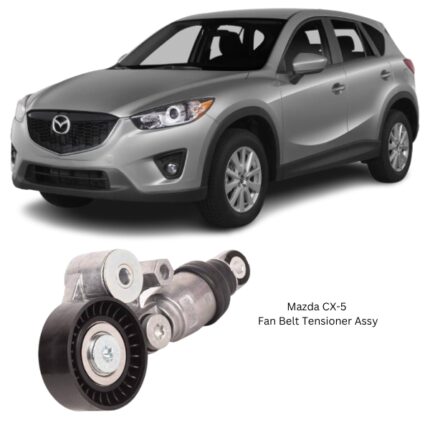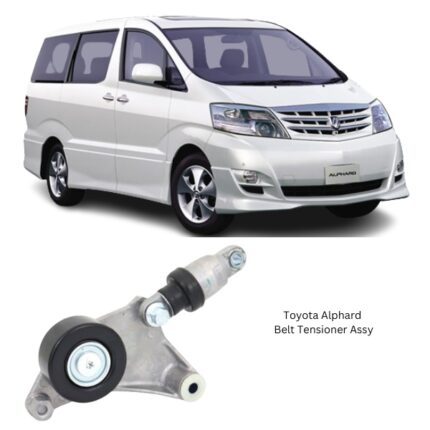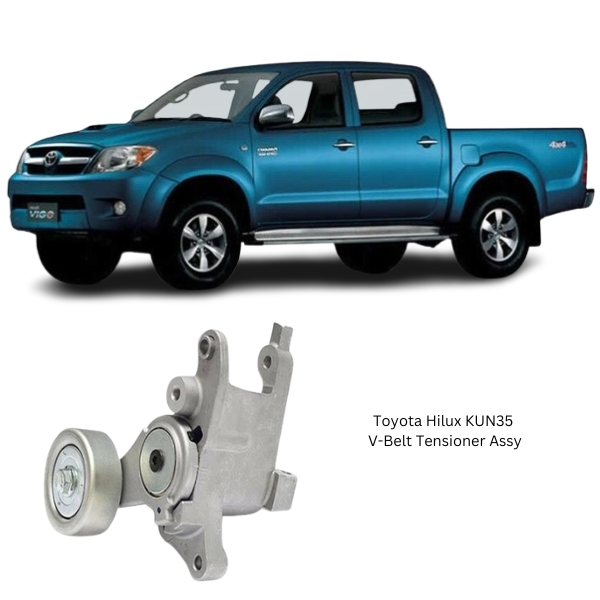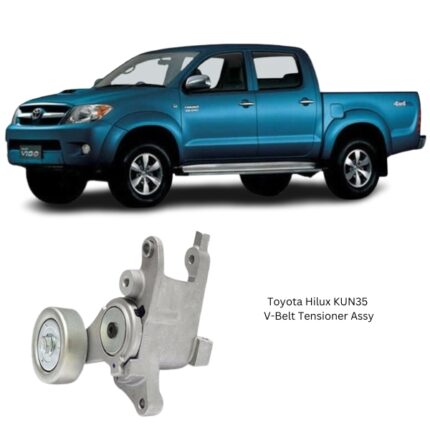Get Toyota Hilux KUN35 V-Belt Tensioner Assy 16620-0L020 in Kenya
The V-Belt Tensioner Assembly is a critical mechanical component designed to regulate and maintain optimal tension in a V-belt drive system. It ensures consistent power transmission between the engine’s crankshaft and various auxiliary components such as the alternator, water pump, air conditioning compressor, and power steering pump. By maintaining the appropriate tension in the V-belt, the tensioner helps reduce slippage, minimize belt wear, and prevent premature failure of connected accessories.
In traditional V-belt systems, especially in industrial engines and some automotive configurations, the tensioner assembly plays a vital role in delivering long-term reliability and smooth system operation.
Function and Purpose
The primary role of the V-belt tensioner assembly is to apply consistent and automatic tension to the V-belt as it drives various engine accessories. Over time, V-belts may stretch or wear, which can lead to loss of grip, noise, or system malfunction. The tensioner accommodates these changes by adjusting belt pressure dynamically—without requiring manual re-tightening.
Proper tension prevents:
-
Belt Slippage – which leads to reduced efficiency.
-
Over-tightening – which may stress accessory pulleys and bearings.
-
Vibration and noise – caused by loose or uneven belt movement.
This ensures continuous, quiet, and efficient accessory drive operation across a range of operating conditions.
Assembly Structure and Components
A typical V-belt tensioner assembly comprises several key parts, engineered to function in unison:
1. Tensioner Arm
The tensioner arm is the movable component that holds the pulley and reacts to the force of the internal spring. It pivots around a fixed axis to apply pressure on the belt. The arm must be strong yet lightweight to ensure fast response and durability. Materials such as forged aluminum or reinforced steel are commonly used.
2. Pulley
Mounted on the tensioner arm, the pulley is the part that contacts and presses against the V-belt. It may feature a smooth or grooved surface depending on the belt profile. It includes a sealed bearing system that allows it to rotate freely and silently under continuous load. High-quality bearings reduce noise, friction, and wear.
3. Internal Spring Mechanism
This is the force-generating component of the tensioner. It may be a torsion spring or coil spring, delivering constant pressure to the arm and pulley to maintain belt tension. The spring must be calibrated precisely to apply the right amount of force without overloading the belt or driven accessories.
4. Damping Mechanism (optional)
Some V-belt tensioners incorporate a mechanical or hydraulic damper to absorb shock and reduce belt oscillations. This ensures smoother performance, especially under fluctuating engine loads or rapid RPM changes.
5. Mounting Base
The mounting section anchors the assembly to the engine block or accessory bracket. It houses the pivot point and ensures structural rigidity and correct alignment.
6. Travel Stop or Limiter
A mechanical limiter may be integrated to prevent over-rotation of the tensioner arm, which can occur if the belt snaps or excessive slack develops.
Material and Construction
The materials used in a V-belt tensioner assembly must meet high standards of strength, heat resistance, and corrosion protection due to the challenging environment inside the engine bay:
-
Tensioner Arm & Base: Typically constructed from aluminum die-cast alloys, cast iron, or heavy-duty stamped steel.
-
Pulley: Made from polymer composite, glass-reinforced plastic, or coated steel. Pulley bearings are usually high-precision, sealed, and pre-lubricated for life.
-
Springs: Produced from heat-treated spring steel or stainless steel with high fatigue resistance.
-
Bearings: Double-shielded and grease-packed to withstand thermal expansion, dust, and moisture.
These components are designed to survive thermal cycling, vibration, engine oil vapors, and occasional exposure to road splash and debris.
Operational Characteristics
The V-belt tensioner assembly is continuously active while the engine runs. Its performance characteristics include:
-
Dynamic Self-Adjustment: The spring mechanism compensates for V-belt stretch or wear automatically without manual adjustment.
-
Controlled Belt Contact: The tensioner ensures the V-belt maintains constant contact with accessory pulleys, maximizing grip and energy transfer.
-
Vibration Damping: Through its pivot and, if present, damping system, the tensioner suppresses harmonic vibrations that may otherwise damage pulleys or generate noise.
This dynamic performance contributes to improved system reliability and reduced need for regular maintenance.
Thermal and Environmental Performance
A V-belt tensioner must endure wide-ranging operating conditions:
-
Temperature Range: Tensioners typically operate within –30°C to +150°C (–22°F to 302°F), with brief exposure to higher temperatures near the exhaust manifold.
-
Contaminant Exposure: The assembly is exposed to dust, oil, coolant mist, and water, requiring robust sealing and corrosion-resistant materials.
-
Load Variability: Engine load fluctuations and RPM changes can cause stress cycling. The spring and damping system are designed to handle frequent adjustments and shock absorption.
Proper tensioner performance ensures system stability across these demanding conditions.
Symptoms of Wear or Failure
Like any mechanical part, the V-belt tensioner assembly will degrade over time due to repeated cycling, heat, and bearing wear. Common signs of failure include:
-
Belt Noise (squealing or chirping): Often indicates poor tension or bearing degradation.
-
Excessive Belt Slack: Caused by weakened springs or a seized pivot.
-
Pulley Wobble or Misalignment: Suggests bearing failure or structural deformation.
-
Tensioner Arm Flutter: Indicates damping failure, leading to visible arm oscillations.
-
Unusual Engine Noise: Such as rattling or knocking from the tensioner area.
Left unaddressed, a faulty tensioner may lead to V-belt slippage, accessory malfunction, or even complete system shutdown.
Installation and Service Considerations
Although V-belt tensioners are generally maintenance-free, proper installation ensures full functionality and long service life:
-
Alignment: Misalignment during installation can result in rapid belt wear or pulley damage.
-
Torque Specification: Mounting bolts should be tightened to OEM-recommended torque values to prevent loosening or thread damage.
-
Belt Inspection: The belt must be routed correctly and inspected for wear when installing a new tensioner.
-
Replacement Interval: While not usually listed as a wear item, it is often advisable to replace the tensioner along with the belt to avoid future failure.
Advantages of a Properly Functioning Tensioner
A V-belt tensioner assembly, when functioning optimally, provides numerous system benefits:
-
Improved Accessory Performance: Ensures constant and full power delivery to components like the alternator and AC compressor.
-
Noise Reduction: Prevents belt slap, squeal, and other noise associated with loose belts.
-
Extended Belt Life: Minimizes wear due to slipping or over-tightening.
-
Enhanced Efficiency: Reduces friction losses by maintaining optimal belt tension.
Follow us on Facebook for more parts.





Reviews
Clear filtersThere are no reviews yet.